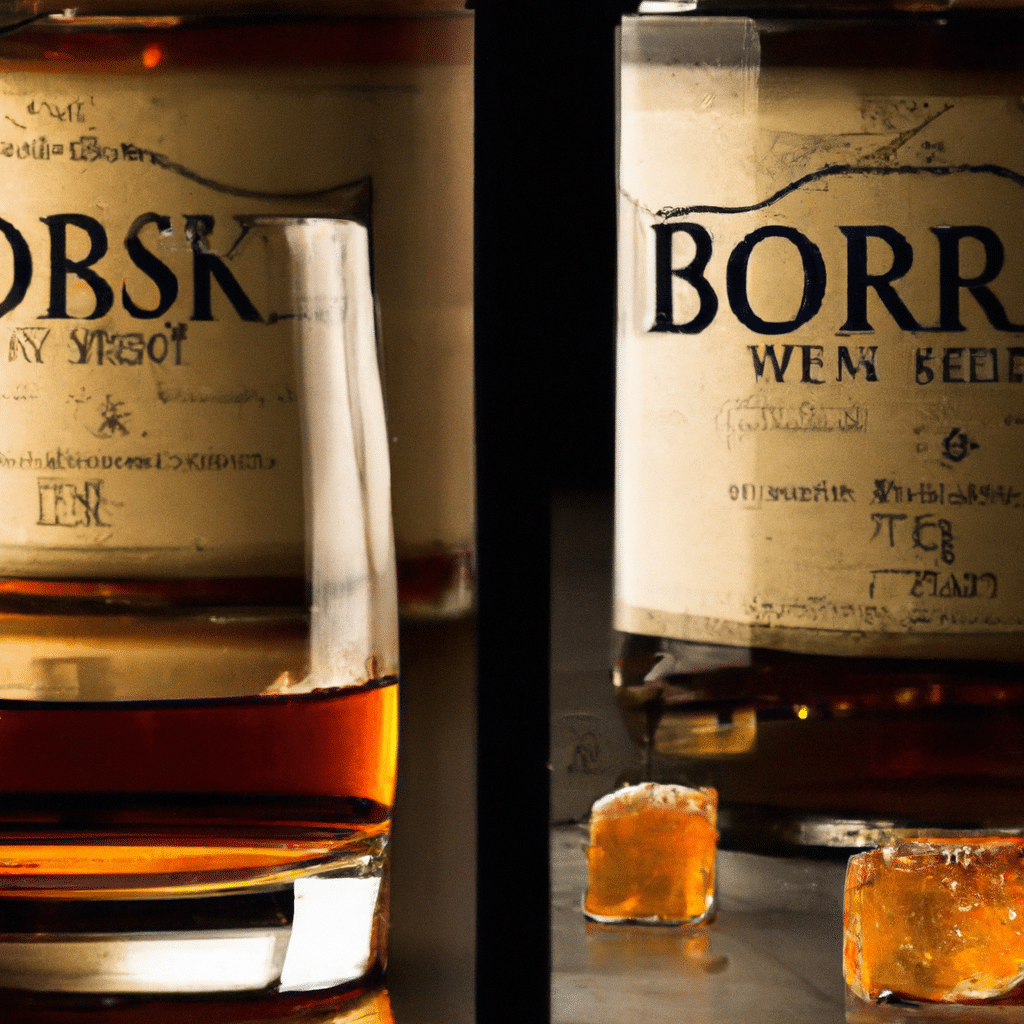Ah, the never-ending debate of bourbon versus rye whiskey – a topic that has sparked many conversations, divided countless enthusiasts, and fueled a fair share of friendly arguments. But fear not, fellow beverage connoisseurs, for we are here to shed some light on this age-old question. In a world brimming with an array of intoxicating libations, it’s easy to get lost amidst the vast selection at your local distillery. So, join us as we embark on a journey to unravel the nuances, flavors, and origins that distinguish bourbon from rye whiskey. Whether you’re a seasoned whiskey sipper or new to the wondrous realm of spirits, let’s dive into the delicious details and satisfy our curiosity with some whiskey wisdom.
Ingredients
When it comes to bourbon and rye whiskey, one of the key differences lies in the main ingredient used in their production. Bourbon is primarily made from corn, while rye whiskey is predominantly made from rye. The use of different grains gives each of these spirits its own unique flavor profile and characteristics.
For bourbon, the mash bill must contain a minimum of 51% corn. This high corn content contributes to its sweetness and smoothness, making it a favorite among many whiskey enthusiasts. On the other hand, rye whiskey requires a minimum of 51% rye in its mash bill. This higher rye content gives rye whiskey a distinct spiciness and fruitiness, setting it apart from its corn-based counterpart.
Fermentation
Another aspect that sets bourbon and rye whiskey apart is the fermentation process. Bourbon is typically produced using yeast-based fermentation, which helps convert the sugars in the mash into alcohol. This method allows for the development of complex flavors and aromas, contributing to the rich and smooth character of bourbon.
In contrast, rye whiskey often utilizes fermented malted grains. This means that the grains used in the production of rye whiskey are sprouted and partially dried before being mashed and fermented. This process adds an additional layer of complexity to the whiskey, resulting in a unique flavor profile that combines the spiciness of rye with the earthy and malty notes from the malted grains.
Distillation Process
The distillation process is another factor that plays a role in the distinction between bourbon and rye whiskey. Both types of whiskey can be produced using a combination of pot stills and column stills, allowing for versatility in the production process.
For bourbon, the choice of distillation method can influence the final product. The use of pot stills can result in a more robust and flavorful bourbon, while column stills can produce a lighter and smoother spirit. The combination of these two distillation methods gives distilleries the flexibility to create a wide range of bourbon expressions for whiskey enthusiasts to enjoy.
Similarly, rye whiskey can also be crafted using either pot stills or column stills or a combination of both. This gives distillers the freedom to experiment with the distillation process, allowing them to create rye whiskeys with varying levels of complexity and intensity.
Aging Requirements
Both bourbon and rye whiskey have minimum aging requirements to be labeled as “Straight” whiskey. To be considered Straight Bourbon, the whiskey must be aged in new, charred oak barrels for a minimum of two years. This aging process allows the whiskey to develop its flavors and aromas, resulting in a more refined and enjoyable drinking experience.
Likewise, Straight Rye Whiskey also has a minimum aging requirement of two years in new, charred oak barrels. This aging period allows the rye whiskey to mellow and develop its distinct spicy and fruity characteristics. However, it’s worth noting that many bourbon and rye whiskeys on the market today exceed these minimum aging requirements, with some being aged for several years or even decades.
Flavor Profile
The flavor profile of bourbon and rye whiskey is where the true differences shine through. Bourbon, with its higher corn content, is known for its sweet and smooth characteristics. The corn contributes a natural sweetness to the spirit, while the aging process in charred oak barrels adds flavors such as caramel, vanilla, and oak. These flavors, combined with the rich mouthfeel, make bourbon a crowd-pleasing choice for whiskey lovers.
Rye whiskey, on the other hand, offers a distinct flavor profile that sets it apart from bourbon. With its higher rye content, rye whiskey is known for its spiciness and fruitiness. The spicy notes can range from subtle to bold, with flavors like black pepper, cinnamon, and cloves making appearances. Additionally, rye whiskey often exhibits fruity notes, including citrus, cherry, and apple, which add complexity to its profile.
Regions of Production
Bourbon is primarily associated with the United States, particularly the state of Kentucky. The unique climate and limestone-rich water in this region contribute to the production of high-quality bourbon. While bourbon can be made anywhere in the United States, it is predominantly produced in Kentucky.
Rye whiskey, on the other hand, has a broader range of production regions. While the United States is a major producer of rye whiskey, Canada also holds a significant place in its production. Canadian rye whiskey often blends rye with other grains and is known for its light and smooth character. The combination of American and Canadian rye whiskeys provides whiskey enthusiasts with a diverse range of options to choose from.
Popularity and Demand
Bourbon has experienced a tremendous surge in popularity in recent years. With its smooth and approachable flavor profile, bourbon has become the go-to choice for many whiskey enthusiasts. Its versatility makes it suitable for sipping neat, on the rocks, or as the base for countless cocktail recipes. The rise of bourbon’s popularity has led to an increase in the number of craft distilleries producing this beloved spirit.
Rye whiskey, on the other hand, has seen a resurgence in popularity. Once overshadowed by bourbon, rye whiskey has gained a loyal following of its own. Its bold and spicy nature has attracted whiskey connoisseurs looking for something different. Bartenders and mixologists have also embraced rye whiskey for its unique flavor profile and its ability to add depth and complexity to classic cocktails.
Mixology
When it comes to mixology, bourbon offers a wide range of possibilities. Its rich and sweet flavor profile makes it a versatile base for a variety of cocktails. From timeless classics like the Old Fashioned and the Mint Julep to modern creations, bourbon adds depth and complexity to cocktail recipes. It can also be enjoyed in simple mixed drinks like the Bourbon and Coke or bourbon-based variations of other spirits, such as the Boulevardier.
Rye whiskey, on the other hand, is often the preferred choice for classic cocktails. Its spicy and assertive character pairs well with the bold flavors found in drinks like the Manhattan and the Sazerac. Rye whiskey’s unique flavor profile shines through in these cocktails, adding a distinctive twist to familiar recipes. The boldness of rye whiskey can also hold its ground in complex and spirit-forward drinks, making it a favorite among mixologists looking to elevate their creations.
Food Pairing
Bourbon and rye whiskey offer distinct flavor profiles that can complement a wide range of foods. When it comes to pairing bourbon with food, its sweetness and smoothness make it a perfect match for rich and sweet dishes. The caramel and vanilla notes found in bourbon can enhance the flavors of desserts like pecan pie or bread pudding. Additionally, bourbon’s smooth finish can help balance the richness of dishes like barbecue, grilled meats, and even chocolate.
Rye whiskey, with its spiciness and complexity, pairs well with savory and spicier foods. The bold flavors of rye whiskey can harmonize with flavors found in dishes like spicy Mexican cuisine, charcuterie boards, and flavorful cheeses. Rye whiskey’s ability to cut through rich and fatty foods also makes it an excellent accompaniment to dishes like smoked salmon or pastrami sandwiches.
In conclusion, while both bourbon and rye whiskey are beloved spirits, they offer distinct characteristics that cater to different preferences. Bourbon, with its sweetness and smoothness, has gained widespread popularity and versatility in mixology. Rye whiskey, on the other hand, is known for its spiciness and fruitiness, making it a favorite among those seeking bolder flavors. Whether enjoyed straight, in cocktails, or paired with food, both bourbon and rye whiskey have their own unique charm that continues to captivate whiskey enthusiasts around the world.


